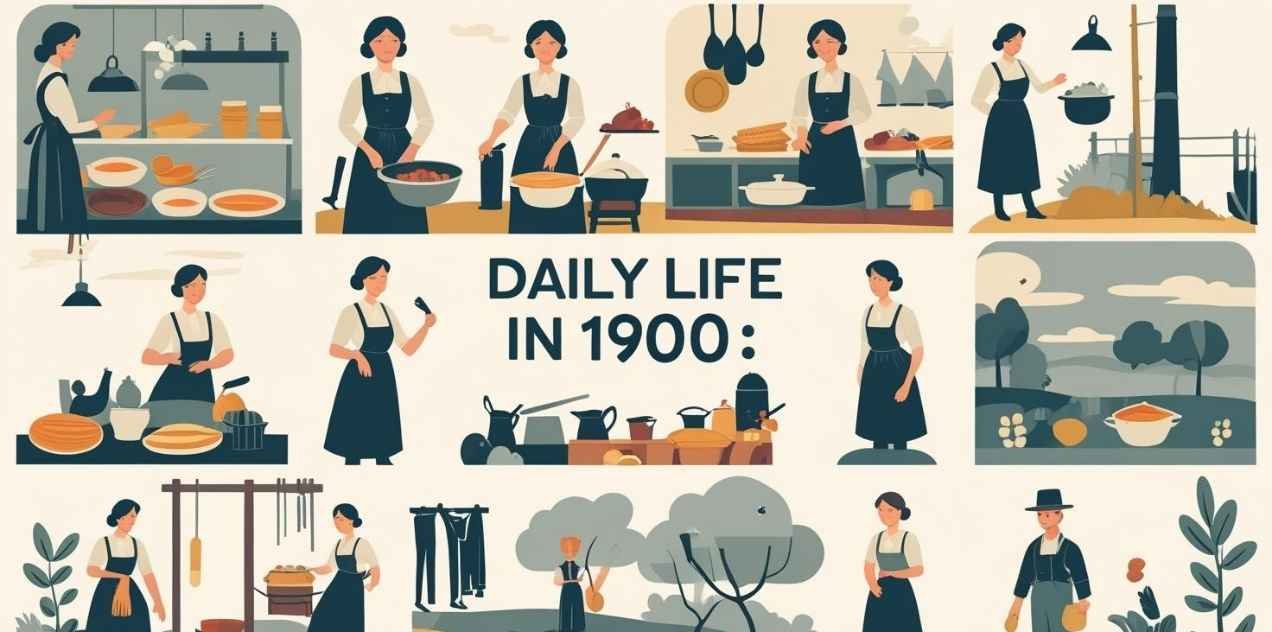Introduction – Stepping Into the Past
Life in 1900 smells faintly of coal smoke and freshly baked bread.
Your shoes click on uneven cobblestones as a horse-drawn carriage rattles past.
It’s a world balancing tradition and change.
Approximately 1.65 billion people live on Earth, which is a small portion of the current 8 billion.
Cities hum with the noise of factories, while vast countryside stretches untouched.
Electric lights flicker in some streets, but oil lamps still glow in kitchen windows.
Life here is slower, quieter, and far more connected to the earth.
People dress with care, cook from scratch, and live by the rhythm of the seasons.
Defining “Life in 1900”
When we talk about life in 1900, we’re looking at a bridge between centuries.
The 19th century’s traditions are still strong, but the 20th century’s innovations are knocking at the door.
It’s a time of:
- Handmade clothing that fits like it was meant for you.
- Meals cooked over stoves fueled by wood, coal, or gas.
- Family gatherings as the main evening entertainment.
It’s also a time of contrasts — a wealthy merchant in Paris might have electric lights and a telephone, while a farmer in rural China cooks over an open fire and lights the evening with candles.
Origin – The World on the Edge of Change
Neither the ancient world nor the new one fully encompasses the year 1900.
The Industrial Revolution has transformed cities:
- Trains whistle across the countryside.
- Steamships carry goods across oceans.
- Telephones are rare but possible.
Still, much of the planet lives as it has for centuries — plowing fields by hand, weaving clothes at home, cooking on hearths.
The century ahead will bring cars, airplanes, radios, and world wars.
But in this moment, life is both familiar and foreign to us.
Fashion in 1900 – Clothing as a Second Skin
Women’s Style – Beauty in Layers
Step into a 1900 dressing room and you’ll see layers — so many layers.
The chemise, a plush cotton undergarment, arrives first.
The corset, which is tight-laced to form the waist, comes next.
Over that: petticoats, a blouse, and a long skirt.
Winter fabrics are heavy wool; summer fabrics are light cotton or linen.
Colors follow the seasons — deep jewel tones in winter, pale creams and pinks in summer.
The crowning glory is the hat — wide-brimmed, dripping with ribbons, feathers, or even whole artificial birds.
Men’s Style – Respect in the Details
A man in 1900 is rarely without a jacket.
Even for daily tasks, the three-piece suit—jacket, waistcoat, and pants—is the norm.
Shirts are crisp, collars stiff, and neckties knotted with precision.
Hats are essential — a bowler for work, a top hat for formal occasions.
Shoes are leather and kept polished to a mirror shine.
Children’s Style – Miniature Adults
Children are dressed much like their parents.
Boys wear short trousers and suspenders; girls wear dresses with pinafores.
Play clothes are rare — the idea of “casual wear” doesn’t really exist yet.
Cooking in 1900 – The Heart of the Home
The kitchen is warm and fragrant, often the most comfortable room in the house.
In cities, stoves burn coal or gas.
A wood-burning stove serves as both an oven and a warmth in rural dwellings.
Everyday Meals
Cooking is guided by seasonal availability:
- Breakfast: Oatmeal, bread with butter, or eggs.
- Lunch: Soup, cold meat, or cheese.
- Dinner: Stew, roast meat, potatoes, and vegetables.
Desserts are simple — fruit pies, custards, or sponge cakes.
Cooking Skills
Everything is made from scratch.
Recipes are handed down and are frequently learned by heart rather than recorded.
Women (and sometimes men) spend hours baking bread, churning butter, and canning vegetables.
Preservation
Without refrigerators, iceboxes are used in cities.
In rural areas, root cellars keep potatoes, carrots, and apples fresh for months.
Canning is an autumn ritual, sealing jars of beans, peaches, or pickles for winter.
FOR MORE BLOG PLS VISIT : DAILY LIFE WAYS
Everyday Life – Work, Leisure, and Rhythm
Work
For many, the day begins at dawn.
Farmers feed animals before breakfast; factory workers walk to their shifts; shopkeepers sweep the storefront.
Men dominate heavy labor, while women manage homes, raise children, and sometimes work as seamstresses, teachers, or nurses.
Leisure
Evenings are for reading, sewing, playing music, or visiting neighbors.
The radio isn’t yet widespread, so entertainment is live — songs around the piano, storytelling by the fire.
Dances, church gatherings, and fairs are major social events.
Travel and Communication
Horses, bicycles, and walking are the norm.
Major cities are connected by railroads, and passengers are transported across the oceans by ocean liners.
Communication is by letter — treasured, handwritten, and sometimes scented with perfume.
Real-World Lessons from 1900 for Today
The lifestyle of 1900 offers surprising inspiration:
- Clothing designed to last rather than be thrown away is known as slow fashion.
- Seasonal eating — healthier for people and the planet.
- Community bonds — dinners without screens, neighbors helping neighbors.
- Self-reliance — mending clothes, preserving food, and knowing basic skills.
Comparison – Then vs. Now
| Aspect | 1900 | Today |
| Clothing | Handmade, tailored, durable | Mass-produced, disposable |
| Cooking | From scratch, seasonal | Processed, imported year-round |
| Communication | Letters, telegrams | Instant global messaging |
| Transport | Horses, trains, walking | Cars, planes, high-speed rail |
| Population | 1.65 billion | 8+ billion |
Future Implications – Why the Past Still Matters
As the world grows faster and more digital, the lessons of life in 1900 may become even more valuable.
- Climate concerns may push us toward local food systems.
- Economic instability may bring back repair culture.
- Overstimulation may make slower, more deliberate living attractive again.
But we must also remember the limits of that era — lack of modern medicine, gender restrictions, and social inequalities.
Best Practices – Living with a 1900 Mindset
- Choose quality clothing over cheap trends.
- Cook at home using fresh, seasonal foods.
- Preserve food to reduce waste.
- Repair before replacing to save money and resources.
- Foster community through shared meals and gatherings.
Conclusion – Holding the Thread of Time
Life in 1900 was a tapestry woven from patience, skill, and community.
Clothing was crafted with care, meals were made with love, and the pace of life allowed people to notice the seasons change.
In an age of world population growth and fast living, perhaps the greatest gift we can take from 1900 is the reminder that slower can sometimes mean richer.
FAQs
1. How did women dress in 1900?
wearing long skirts, hats, and corsets in layered ensembles.
2. How did people cook in 1900?
On coal, gas, or wood stoves, using fresh, seasonal ingredients.
3. How did families preserve food?
By canning, drying, and storing in root cellars.
4. What was the world’s population in 1900?
About 1.65 billion people.
5. Did most homes have electricity?
Some city homes did, but rural areas relied on oil lamps.
CLICK HERE TO EXPERIENCE MORE ABOUT LIFE IN 1900








